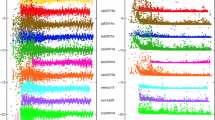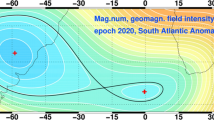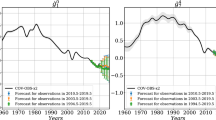Abstract
The attempt to quantify the corrections of lunisolar nutation components was made after analysis of six sets of Earth’s orientation parameters (EOP). The deviations of the long-term nutation components about IAU2006/IAU2000A precession–nutation model are consistent with the uncertainties suggested by Mathews et al. (J Geophys Res Solid Earth, 2002. https://doi.org/10.1029/2001JB000390), but they exceed the errors determined in this work. The corrections are validated using the IERS 14C04 and IVS 19q4e combined solutions. After applying the corrections found in this work to the 14C04 nutation residuals, we analyzed the remaining signals, which contain the signature of the free core nutation (FCN). The eigenperiod of the FCN is fixed to the value derived from the resonance of the non-hydrostatic earth model in a priori. The amplitude of FCN is computed by fitting observations to the empirical model using a sliding window, the length of window is determined by taking into account the interference between those close nutation components and the FCN. In addition, we also fitted the nutation residuals by a viscous damping function; both methods produce the same results in the amplitudes of FCN. The magnitude of the free core nutation bears a “V-shape” distribution, and furthermore, the oscillation of the FCN shows a decay and a steady reinforcement before and after 1999. In order to examine the origin of the modulation in FCN’s magnitude, we briefly analyzed the possible damping or beating mechanism behind it. We diagnosed the magnitude and running phase changes of FCN by comparing it with the occurrence of the transient geomagnetic jerks. The weighted root mean square errors of nutation residuals are minimally reduced about \(36\%\) when the corrections to the 21 nutation components and the FCN signature are considered together.












Similar content being viewed by others
Data availibility
The IERS 14C04 EOP solution are available from the IERS website (http://www.iers.or) and the IVS 19q4e is accessible through http://cddis.nasa.gov All processed data and Fis20 series and the nutation series developed in the past are accessible through http://gitlab-as.oma.be/zhuping/earths-nutation.
References
Altamimi Z, Rebischung P, Métivier L, Collilieux X (2016) ITRF2014: a new release of the international terrestrial reference frame modeling nonlinear station motions. J Geophys Res Solid Earth 121(8):6109–6131. https://doi.org/10.1002/2016JB013098
Behrend D, Böhm J, Charlot P, Clark T, Corey B, Gipson J, Haas R, Koyama Y, MacMillan D, Malkin Z et al (2009) Recent progress in the VLBI2010 development. In: Sideris MG (ed) Observing our changing earth. Springer, Berlin, pp 833–840. https://doi.org/10.1007/978-3-540-85426-5_96
Belda S, Ferrandiz JM, Heinkelmann R, Nilsson T, Schuh H (2016) Testing a new free core nutation empirical model. J Geodyn 94:59–67. https://doi.org/10.1016/j.jog.2016.02.002
Belda S, Heinkelmann R, Ferrándiz JM, Karbon M, Nilsson T, Schuh H (2017) An improved empirical harmonic model of the celestial intermediate pole offsets from a global VLBI solution. Astron J 154(4):166
Bizouard C, Lambert S, Becker O, Richard JY (2018) The IERS EOP 14C04 solution for Earth orientation parameters consistent with ITRF 2014. J Geod 2018:1–13
Bretagnon P, Francou G, Rocher P, Simon J (1998) Smart97: a new solution for the rotation of the rigid Earth. Astron Astrophys 329:329–338
Capitaine N, Wallace PT, Chapront J (2003) Expressions for IAU 2000 precession quantities. Astron Astrophys 412(2):567–586. https://doi.org/10.1051/0004-6361:20031539
Chao BF, Yikai H (2015) The Earth’s free core nutation: formulation of dynamics and estimation of eigenperiod from the very-long-baseline interferometry data. Earth Planet Sci Lett 432:483–492
Charlot P, Jacobs CS, Gordon D, Lambert Sébastien, de Witt A, Böhm J, Fey AL, Heinkelmann R, Skurikhina E, Titov O et al (2020) The third realization of the International Celestial Reference Frame by very long baseline interferometry. A&A 644:A159
Dehant V, Mathews PM (2015) Precession, nutation and wobble of the earth. Cambridge University Press, Cambridge
Dehant V, Feissel-Vernier M, de Viron O, Ma C, Yseboodt M, Bizouard C (2003) Remaining error sources in the nutation at the submilliarc second level. J Geophys Res Solid Earth. https://doi.org/10.1029/2002JB001763
Dehant V, Laguerre R, Rekier J, Rivoldini A, Triana SA, Trinh A, Van Hoolst T, Zhu P (2017) Understanding the effects of the core on the nutation of the Earth. Geod Geodyn. https://doi.org/10.1016/j.geog.2017.04.005
Ericsson T, Ruhe A (1980) The spectral transformation Lanczos method for the numerical solution of large sparse generalized symmetric eigenvalue problems. Math Comput 35(152):1251–1268
Gattano C, Lambert SB, Bizouard C (2017) Observation of the earth’s nutation by the VLBI: how accurate is the geophysical signal. J Geod 91(7):849–856. https://doi.org/10.1007/s00190-016-0940-7
Hartmann T, Soffel M, Ron C (1999) The geophysical approach towards the nutation of a rigid Earth. Astron Astrophys Suppl Ser 134(2):271–286
Herring T, Gwinn C, Shapiro I (1986) Geodesy by radio interferometry: Studies of the forced nutations of the Earth: 1. Data analysis. J Geophys Res Solid Earth 91(B5):4745–4754
Herring T, Buffett B, Mathews P, Shapiro I (1991) Forced nutations of the earth: Influence of inner core dynamics: 3. Very long interferometry data analysis. J Geophys Res Solid Earth 96(B5):8259–8273
Herring T, Mathews P, Buffett B (2002) Modeling of nutation–precession: very long baseline interferometry results. J Geophys Res Solid Earth. https://doi.org/10.1029/2001JB000165
Hinderer J, Boy JP, Gegout P, Defraigne P, Roosbeek F, Dehant Véronique (2000) Are the free core nutation parameters variable in time? Phys Earth Planet Interiors 117:37–49
Kinoshita H (1977) Theory of the rotation of the rigid Earth. Celest Mech 15(3):277–326
Koot L, Rivoldini A, de Viron O, Dehant V (2008) Estimation of Earth interior parameters from a bayesian inversion of very long baseline interferometry nutation time series. J Geophys Res Solid Earth. https://doi.org/10.1029/2007JB005409
Krásná H, Böhm J, Schuh H (2013) Free core nutation observed by VLBI. Astron Astrophys 555:A29. https://doi.org/10.1051/0004-6361/201321585.371-374
Lambert S (2006) Atmospheric excitation of the Earth’s free core nutation. Astron Astrophys 457(2):717–720. https://doi.org/10.1051/0004-6361:20065813
Malkin Z (2013) Free core nutation and geomagnetic jerks. J Geodyn 72:53–58. https://doi.org/10.1016/j.jog.2013.06.001
Mandea M, Holme R, Pais A, Pinheiro K, Jackson A, Verbanac G (2010) Geomagnetic jerks: rapid core fild variations and core dynamics. Space Sci Rev 155:147–175. https://doi.org/10.1007/s11214-010-9663-x
Mathews P, Herring T, Buffett B (2002) Modeling of nutation and precession: new nutation series for nonrigid earth and insights into the Earth’s interior. J Geophys Res Solid Earth. https://doi.org/10.1029/2001JB000390
Petit G, Luzum B (2010) IERS Conventions, Verlag des Bundesamts für Kartographie und Geodäsie Frankfurt am Main 2010, pp 56–58
Petrov L (2007) The empirical Earth rotation model from VLBI observations. A&A 467:359–369
Rekier J, Triana SA, Trinh A, Dehant V (2020) Inertial modes of a freely rotating ellipsoidal planet and their relation to nutations. (Accepted to appear in PSJ)
Roosbeek F, Dehant V (1998) RDAN97: an analytical development of rigid Earth nutation series using the torque approach. Celest Mech Dyn Astron 70(4):215–253
Roosbeek F, Defraigne P, Feissel M, Dehant V (1999) The free core nutation period stays between 431 and 434 sidereal days. Geophys Res Lett 26:131–134
Saad Y (2003) Iterative methods for sparse linear systems. SIAM, Philadelphia
Seidelmann P (1982) 1980 IAU theory of nutation: the final report of the IAU working group on nutation. Celest Mech 27(1):79–106
Shirai T, Fukushima T, Malkin Z (2005) Detection of phase disturbances of free core nutation of the Earth and their concurrence with geomagnetic jerks. Earth Planets Space 57:151–155
Soffel M, Klioner SA, Petit G, Wolf P, Kopeikin SM, Bretagnon P, Brumberg VA, Capitaine N, Damour T, Fukushima T et al (2003) The IAU2000 resolutions for astrometry, celestial mechanics, and metrology in the relativistic framework: explanatory supplement. Astron J 126(6):2687–2706
Souchay J, Loysel B, Kinoshita H, Folgueira M (1999) Corrections and new developments in rigid earth nutation theory—III. Final tables. Astron Astrophys Suppl Ser 135(1):111–131
Triana SA, Rekier J, Trinh A, Dehant V (2019) The coupling between inertial and rotational eigenmodes in planets with liquid cores. Geophys J Int 218(2):1071–1086. https://doi.org/10.1093/gji/ggz212
Van Hoolst T (2005) Resonances between two stellar oscillation modes with nearly equal frequencies. A&A 295:371–392
Vondrak J, Weber R, Ron C (2005) Free core nutation: direct observations and resonance effects. A&A 444(1):297–303
Wahr J (1981) The forced nutations of an elliptical, rotating, elastic and oceanless earth. Geophys J Int 64(3):705–727
Zhu S, Groten E, Reigber C (1990) Various aspects of numerical determination of nutation constants. II—an improved nutation series for the deformable earth. Astron J 99:1024–1044
Zhu P, Rivoldini A, Koot L, Dehant V (2017) Basic earth’s parameters as estimated from VLBI observations. Geod Geodyn 8(6):427–432. https://doi.org/10.1016/j.geog.2017.04.007
Zhu P, Triana AS, Rekier J, Trinth A, Dehant V, Rotanut team (2020) EarTh’s NutAtion computation packages (ETNA). https://doi.org/10.24414/mrh3-fc03
Acknowledgements
The authors are grateful to anonymous reviewers for their careful reading of our manuscript and their many insightful comments and suggestions. This study was supported by the ERC Grant ROTANUT (670874) and GRACEFUL (855677).
Author information
Authors and Affiliations
Contributions
PZ has developed the Earth NuTAtion code and written the overall manuscript. SAT, JR and AT have contributed to the verification of the code, the description and the discussion part of FCN. VD has joined the analysis and polished the complete manuscript.
Corresponding author
A Appendix
A Appendix
The 11 sets of EOP solutions are used to estimate the uncertainties of the 21 nutation component are showed in Fig. 9.
We computed the power spectral density with the complex number (\(\mathrm{d}X+i\mathrm{d}Y\)) built from the IERS and IVS corrected residuals (Fig. 10), which partly explains the diversity of the eigen-period of the FCN found by different studies. One possible interpretation about the wider \(\delta T\) is that the eigen-period and phase of FCN may be changed due to the rotation of the Earth as indicated by Krásná et al. (2013), which hints a splitting of the mode; however, this need be investigated further.
We tested different window lengths starting from 2 to 8 years (Fig. 11) and compared the results with 4 years time window (Fig. 12). The amplitude of the short-term oscillations were decreasing with the increasing of the length of the window. The time reference is the mid point of each window. We used a one day sliding step to track the time variation of the mode.
Rights and permissions
About this article
Cite this article
Zhu, P., Triana, S.A., Rekier, J. et al. Quantification of corrections for the main lunisolar nutation components and analysis of the free core nutation from VLBI-observed nutation residuals. J Geod 95, 57 (2021). https://doi.org/10.1007/s00190-021-01513-9
Received:
Accepted:
Published:
DOI: https://doi.org/10.1007/s00190-021-01513-9




